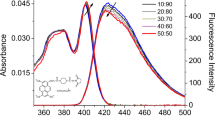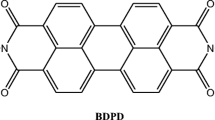Abstract
The effects of concentration on the fluorescence decay kinetics of disulfonated aluminium phthalocyanine (AlPcS2) were studied in several solvents. The degree of aggregation, which increased with total dye concentration, was estimated from the absorption spectra. The measured fluorescence decays were shorter and increasingly non-monoexponential with increasing dye concentration. However, stronger quenching was not correlated with higher aggregation. The fluorescence decays were analyzed using a model that assumes excitation energy migration between diffusing monomeric AlPcS2 and quenching by diffusing dimers, both governed by the Förster energy transfer mechanism. The model can explain the observations in three of the four solvents used (phosphate-buffered saline (PBS) pH = 11.5, ethanol, and 67% glycerol–33% water mixture) on the assumption that different dimer configurations are present and not all of them act as quenchers. In PBS at pH = 7.4 the theory predicts much stronger quenching than observed. Excitation energy migration between monomeric species at high dye concentration was confirmed by the observed decrease of the decay time of fluorescence anisotropy in viscous solutions of 67% glycerol, and appears to be a major factor in fluorescence quenching of AlPcS2 at high concentration.
Similar content being viewed by others
References
D. Phillips, Chemical mechanisms in photodynamic therapy with phthalocyanines, Progress in Reaction Kinetics, 1997, 22, 3–4, 175–300.
A. Beeby, S. M. Bishop, H. G. Meunier, M. S. C. Simpson, and D. Phillips, Complexing of fluoride ions to disulphonated aluminium phthalocyanine, in Photodynamic therapy and biomedical lasers, eds. P. Spinelli, M. Dal Fante and R. Marchesini, Elsevier, Amsterdam, 1992, 732–736.
M. S. C. Foley, A. Beeby, A. W. Parker, S. M. Bishop and D. Phillips, Excited triplet state photophysics of the sulphonated aluminum phthalocyanine bound to human serum albumin, J. Photochem. Photobiol. B, 1997, 38, 10–17.
S. Dhami, A. J. De Mello, G. Rumbles, S. M. Bishop, D. Phillips and A. Beeby, Phthalocyanine fluorescence at high concentration: dimers or reabsorption effect?, Photochem. Photobiol., 1995, 61, 341–346.
M. S. C. Foley, A. Beeby, A. W. Parker, S. M. Bishop and D. Phillips, Photophysics of disulphonated aluminum phthalocyanine in reverse micelles of Aerosol OT, J. Photochem. Photobiol. B, 1997, 38, 18–24.
S. Dhami, J. J. Cosa, S. M. Bishop and D. Phillips, Photophysical characterization of sulfonated aluminum phthalocyanines in a cationic reversed micellar system, Langmuir, 1996, 12, 2, 293–300.
S. Dhami, G. Rumbles, A. J. MacRobert and D. Phillips, Comparative photophysical study of disulfonated aluminum phthalocyanine in unilamellar vesicles and leukemic K562 cells, Photochem. Photobiol., 1997, 65, 1, 85–90
S. Dhami and D. Phillips, Comparison of the photophysics of an aggregating and non-aggregating aluminium phthalocyanine system incorporated into unilamellar vesicles, J. Photochem. Photobiol. A, 1996, 100, 1–3, 77–84.
M. Ambroz, A. J. MacRobert, J. Morgan, G. Rumbles, M. S. C. Foleyand D. Phillips, Time-resolved fluorescence spectroscopy and intracellular imaging of disulphonated aluminium phthalocyanine, J. Photochem. Photobiol. B, 1994, 22, 105–117.
A. L. Plant, Mechanism of concentration quenching of a xanthene dye encapsulated in phospholipid liposomes, Photochem. Photobiol., 1986, 44, 4, 453-459.
R. F. Chen and J. R. Knutson, Mechanism of fluorescence concentration quenching of carboxyfluorescein in liposomes: energy transfer to nonfluorescent dimers, Anal. Biochem., 1988, 172, 61–67
A. D. Scully, A. Matsumoto and S. Hirayama, A time-resolved fluorescence study of electronic excitation-energy transport in concentrated dye solutions, Chem. Phys., 1991, 157, 1–2, 253–269.
K. Nakamura, T. Kowaki, A. D. Scully and S. Hirayama, Quenching of chlorophyll a fluorescence by oxygen in highly concentrated solutions and microdroplets, J. Photochem. Photobiol. A, 1997, 104, 1–3, 141–149.
M. Sikorski, E. Krystkowiak and R. P. Steer, The kinetics of fast fluorescence quenching processes, J. Photochem. Photobiol. A, 1998, 117, 1–16.
C. S. Owen, Two dimensional diffusion theory: Cylindrical diffusion model applied to fluorescence quenching, J. Chem. Phys., 1975, 62, 8, 3204–3207.
D. D. Eads, B. G. Dismer and G. R. Fleming, A subpicosecond, subnanosecond and steady-state study of diffusion influenced fluorescence quenching, J. Chem. Phys., 1990, 93 2, 1136.
S. Jang, K. J. Shin and S. Lee, Effects of excitation migration and translational diffusion in the luminescence quenching dynamics, J. Chem. Phys., 1995, 102 2, 815–827.
H. C. Joshi, H. Mishra, H. B. Tripathi and T. C. Pant, Role of diffusion in excitation energy transfer: a time-resolved study, J. Lumin., 2000, 90, 17–25.
D. L. Andrews and G. Juzeliunas, The range dependence of fluorescence anisotropy in molecular energy transfer, J. Chem. Phys., 1991, 95 8, 5513–5518.
M. Ambroz, A. Beeby, A. J. MacRobert, M. S. C. Simpson, R. K. Svensen, and D. Phillips, Preparative, analytical and fluorescence spectroscopic studies of sulphonated aluminium phthalocyanine photosensitisers, J. Photochem. Photobiol., B, 1991, 9, 87–95.
D. V. O’Connor and D. Phillips, Time-correlated single-photon counting, Academic Press, London, 1984.
P. W. Atkins, Physical Chemistry, Oxford University Press, Oxford, 1990, p. 689.
R. B. Ostler, An investigation of intracellular PDT mechanisms, PhD thesis, University of London, 1997.
R. B. Ostler, A. D. Scully, A. G. Taylor, I. R. Gould, T. A. Smith, A. Waite and D. Phillips, The effect of pH on the photophysics and photochemistry of disulphonated aluminium phthalocyanine, Photochem. Photobiol., 2000, 71, 4, 397-404.
R. S. Knox, Spectral effects of exciton splitting in “statistical pairs”, J. Phys. Chem., 1994, 98, 7270–7273
CRC Handbook of Chemistry and Physics, ed. D. R. Lide, CRC Press Inc., 1995.
T. Tao, Time-dependent fluorescence depolarization and brownian rotational diffusion coefficients of macromolecules, Biopolymers, 1969, 8, 609–632.
G. S. Beddard, S. E. Carlin and G. Porter, Concentration quenching of chlorophyll fluorescence in bilayer lipid vesicles and liposomes, Chem. Phys. Lett., 1976, 43 1, 27–32.
M. S. C. Simpson, A. Beeby, S. M. Bishop, A. J. MacRobert, A. W. Parker, and D. Phillips, Time resolved spectroscopic studies of sulphonated aluminium phthalocyanine triplet states, Proc. SPIE-Int. Soc. Opt. Eng., 1992, 1640, 520–529
Author information
Authors and Affiliations
Additional information
Dedicated to Professor Jean Kossanyi on the occasion of his 70th birthday.
Rights and permissions
About this article
Cite this article
Petrášek, Z., Phillips, D. A time-resolved study of concentration quenching of disulfonated aluminium phthalocyanine fluorescence. Photochem Photobiol Sci 2, 236–244 (2003). https://doi.org/10.1039/b209906c
Received:
Accepted:
Published:
Issue Date:
DOI: https://doi.org/10.1039/b209906c




